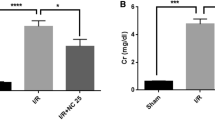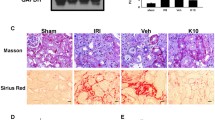Abstract
Cordyceps sinensis (CS) is an entomogenous fungus used as a tonic food and Chinese medicine to replenish health. This study investigated the protective effects of CS in rats post-renal ischemia–reperfusion (I/R) sequence by analyzing the influence on stromal cell-derived factor-1α (SDF-1α and chemokine (C-X-C motif) receptor 4 (CXCR4) expressions and senescence during recovery. Chemokine SDF-1 [now called chemokine C-X-C motif ligand 12 (CXCL12)] and its receptor CXCR4 are crucial in kidney repair after ischemic acute renal failure. CS treatment significantly alleviated I/R-induced renal damage assessed by creatinine levels (p < 0.05) and abated renal tubular damages assessed by periodic acid-Schiff with diastase (PASD) staining. CS induced early SDF-1α expression and increased CXCR4 expression 1–6 h post-reperfusion. Histology studies have revealed that CS induced SDF-1α in squamous cells of Bowman’s capsule, mesangial cells, distal convoluted tubules (DCT), and proximal convoluted tubules (PCT). CS also improved renal repair in I/R-induced injury by increasing Ki-67 staining. I/R induced renal senescence after 3 and 6 h of reperfusion. However, CS alleviated I/R-induced senescence at early stage (1 and 3 h). We conclude that CS protects against I/R injury via the SDF-1/CXCR4-signaling axis and alleviates senescence.






Similar content being viewed by others
References
Zhu JS, Halpern GM, Jones K (1998) The scientific rediscovery of an ancient Chinese herbal medicine: Cordyceps sinensis Part I. J Altern Complement Med 4:289–303
Jordan JL, Sullivan AM, Lee TD (2008) Immune activation by a sterile aqueous extract of Cordyceps sinensis: mechanism of action. Immunopharmacol Immunotoxicol 30:53–70
Guan YJ, Hu Z, Hou M (1992) Effect of Cordyceps sinensis on T-lymphocyte subsets in chronic renal failure. Zhongguo Zhong Xi Yi Jie He Za Zhi 12:338–339
Wang Y, Yin H, Lv X et al (2010) Protection of chronic renal failure by a polysaccharide from Cordyceps sinensis. Fitoterapia 81:397–402
Zhang PL, Lun M, Schworer CM et al (2008) Heat shock protein expression is highly sensitive to ischemia-reperfusion injury in rat kidneys. Ann Clin Lab Sci 38:57–64
Abbate M, Brown D, Bonventre J (1999) Expression of NCAM recapitulates tubulogenic development in kidneys recovering from acute ischemia. Am J Physiol Renal Physiol 277:454–463
Sagrinati C, Ronconi E, Lazzeri E et al (2008) Stem-cell approaches for kidney repair: choosing the right cells. Trends Mol Med 14:277–285
Petit I, Jin D, Rafii S (2007) The SDF-1-CXCR4 signaling pathway: a molecular hub modulating neo-angiogenesis. Trends Immunol 28:299–307
Tögel F, Isaac J, Hu Z et al (2005) Renal SDF-1 signals mobilization and homing of CXCR4-positive cells to the kidney after ischemic injury. Kidney Int 67:1772–1784
Ratajczak MZ, Zuba-Surma E, Kucia M et al (2006) The pleiotropic effects of the SDF-1-CXCR4 axis in organogenesis, regeneration and tumorigenesis. Leukemia 20:1915–1924
Kortesidis A, Zannettino A, Isenmann S et al (2005) Stromal-derived factor-1 promotes the growth, survival, and development of human bone marrow stromal stem cells. Blood 105:3793–3801
Mazzinghi B, Ronconi E, Lazzeri E et al (2008) Essential but differential roles for CXCR4 and CXCR7 in the therapeutic homing of human renal progenitor cells. J Exp Med 205:479–490
Lazzeri E, Crescioli C, Ronconi E et al (2007) Regenerative potential of embryonic renal multipotent progenitors in acute renal failure. J Am Soc Nephrol 18:3128–3138
Joosten SA, van Ham V, Nolan CE et al (2003) Telomere shortening and cellular senescence in a model of chronic renal allograft rejection. Am J Pathol 162:1305–1312
Melk A (2003) Senescence of renal cells: molecular basis and clinical implications. Nephrol Dial Transpl 18:2474–2478
Dimri GP, Lee X, Basile G et al (1995) A biomarker that identifies senescent human cells in culture and in aging skin in vivo. Proc Natl Acad Sci USA 92:9363–9367
Stokman G, Leemans JC, Claessen N et al (2005) Hematopoietic stem cell mobilization therapy accelerates recovery of renal function independent of stem cell contribution. J Am Soc Nephrol 16:1684–1692
Stokman G, Stroo I, Claessen N et al (2010) SDF-1 provides morphological and functional protection against renal ischaemia/reperfusion injury. Nephrol Dial Transpl 25:3852–3859
Chen YP, Liu WZ, Shen LM et al (1986) Clinical effects of natural Cordyceps and cultured mycelia of Cordyceps sinensis in kidney failure. Chin Tradit Herb Drugs 17:256–258
Zhang Z, Wang X, Zhang Y et al (2011) Effect of Cordyceps sinensis on renal function of patients with chronic allograft nephropathy. Urol Int 86:298–301
Ding C, Tian PX, Xue W et al (2011) Efficacy of Cordyceps sinensis in long-term treatment of renal transplant patients. Front Biosci 3:301–307
Shahed AR, Kim SI, Shoskes DA (2011) Down-regulation of apoptotic and inflammatory genes by Cordyceps sinensis extract in rat kidney following ischemia/reperfusion. Transpl Proc 33:2986–2987
O’Donnell MP, Burne M, Daniels F et al (2002) Utility and limitations of serum creatinine as a measure of renal function in experimental renal ischemia-reperfusion injury. Transplantation 73:1841–1844
Robert R, Ghazali DA, Favreau F et al (2011) Gender difference and sex hormone production in rodent renal ischemia reperfusion injury and repair. J Inflamm 8:14
Lin F (2006) Stem cells in kidney regeneration following acute renal injury. Pediatr Res 59:74–78
Lotan D, Sheinberg N, Kopolovic J et al (2008) Expression of SDF-1/CXCR4 in injured human kidneys. Pediatr Nephrol 23:71–77
Jang HR, Gandolfo MT, Ko GJ et al (2010) B cells limit repair after ischemic acute kidney injury. J Am Soc Nephrol 21:654–665
Hall PA, Greenwood RA, D’Ardenne AJ, Levison DA (1988) In situ demonstration of renal tubular regeneration using the monoclonal antibody Ki67. Nephron 49:122–125
Matsunaga H, Handa JT, Aotaki-Keen A, Sherwood SW, West MD, Hjelmeland LM (1999) Beta-galactosidase histochemistry and telomere loss in senescent retinal pigment epithelial cells. Investig Ophthalmol Vis Sci 40:197–202
Fliser D, Zeier M, Nowack R, Ritz E (1993) Renal functional reserve in healthy elderly subjects. J Am Soc Nephrol 3:1371–1377
Acknowledgments
The work was supported by grants from E-Da Hospital/I-Shou University (EDAHP98020 and EDAHP99019) and the National Science Council in Taiwan (NSC 99-2320-B-214-001-MY3).
Author information
Authors and Affiliations
Corresponding author
Rights and permissions
About this article
Cite this article
Wang, HP., Liu, CW., Chang, HW. et al. Cordyceps sinensis protects against renal ischemia/reperfusion injury in rats. Mol Biol Rep 40, 2347–2355 (2013). https://doi.org/10.1007/s11033-012-2316-2
Received:
Accepted:
Published:
Issue Date:
DOI: https://doi.org/10.1007/s11033-012-2316-2




